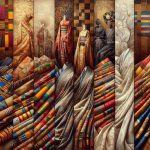Are you curious about lace and its intricate fabric structure? Do you want to know more about the historical origins, types, and characteristics of lace?
In this article, we will explore the world of lace, from its production techniques to its role in fashion and design. We will also discuss how to care for lace and its significance in home decor.
So, if you’re ready to delve into the elegance and femininity of lace, let’s begin!
Table of Contents
Historical Origins of Lace
Lace has its historical origins in intricate handwork techniques dating back centuries. The art of lace making techniques has been practiced by skilled artisans around the world, each region developing its own unique style and patterns.
From delicate bobbin lace made with multiple threads wound on bobbins, to the intricate needle lace created with a single needle and thread, these techniques require precision and patience. Lace patterns are formed by carefully intertwining the threads, creating intricate designs and openwork motifs. These patterns can range from simple geometric shapes to intricate floral motifs, showcasing the creativity and craftsmanship of the lace maker.
Lace has been used throughout history as a decorative element in clothing, accessories, and even home decor. Its beauty and delicacy make it a timeless fabric structure that continues to be cherished and admired today. Whether it is used to embellish a wedding gown or to add a touch of elegance to a tablecloth, lace remains a symbol of sophistication and craftsmanship.
Types of Lace Fabric
There are various types of lace fabric available, each with its own unique characteristics. Lace fabric patterns can range from delicate floral designs to intricate geometric shapes. Some common types of lace fabric include:
-
Chantilly lace: This delicate and lightweight lace is known for its fine floral patterns and scalloped edges. It is often used in bridal gowns and lingerie, adding a touch of elegance and femininity.
-
Guipure lace: Also known as corded lace, this type of lace is characterized by its raised motifs that are connected by fine threads. It is often used in eveningwear and formal dresses, providing a more structured and textured look.
-
Eyelash lace: This type of lace features delicate strands that resemble eyelashes, adding a playful and whimsical touch to any garment. It is commonly used in lingerie, tops, and accessories.
Lace fabric is not only used in clothing but also has various other uses. It is often incorporated into home decor items such as curtains, tablecloths, and pillow covers, adding a touch of elegance and sophistication to any space. Additionally, lace fabric is used in crafting, such as in creating delicate lace trims for cards, scrapbooking, and other art projects.
Characteristics of Lace
Eyelash lace, with its delicate strands resembling eyelashes, adds a playful touch to any garment. Lace has long been regarded as a symbol of romance and delicacy. Its intricate patterns and delicate construction make it a popular choice for wedding dresses.
Lace fabric is made by weaving or knitting threads together in a pattern that creates open spaces. These open spaces give lace its characteristic transparency and lightness. The threads used to make lace can be made from a variety of materials, including silk, cotton, or synthetic fibers.
Lace is often used to create decorative accents on clothing, such as sleeves, collars, or hemlines. It can also be used as an overlay for the entire garment, adding a touch of elegance and femininity.
One of the reasons lace is so popular for wedding dresses is its association with romance and tradition. The delicate and intricate patterns of lace evoke a sense of timeless beauty, making it a perfect choice for brides.
In addition to wedding dresses, lace is also commonly used in lingerie, veils, and accessories like gloves and handkerchiefs. Its delicate and ethereal appearance adds a touch of elegance to any garment, making it a versatile and timeless fabric choice.
Lace Production Techniques
Knitting techniques are commonly employed to create intricate patterns in lace fabric. The art of lace production requires skilled craftsmanship and attention to detail. Handmade lace is created by carefully manipulating yarns with knitting needles or crochet hooks. The process involves creating loops and interlocking them to form delicate patterns. As you work with your needles, you can visualize the lace slowly taking shape, like a web of intricate threads.
Machine made lace, on the other hand, is produced using automated techniques. Complex lace patterns can be replicated quickly and accurately by these machines. The intricate designs are programmed into the machine, which then uses multiple needles to create the lace fabric. The result is a precise and consistent pattern that can be produced in mass quantities.
Imagine the delicate handmade lace being carefully crafted by skilled hands, each stitch meticulously placed. Visualize the intricate patterns slowly emerging as the yarn is transformed into a beautiful lace fabric.
Now, contrast that with the efficiency and speed of the machine, effortlessly producing lace with precision and consistency. The contrast between the two methods highlights the unique qualities of both handmade and machine made lace.
Lace in Fashion and Design
Contrasting the intricate artistry of handmade lace with the efficiency of machine production, lace has become a staple in fashion and design. The delicate and intricate patterns of lace add a touch of elegance and femininity to various garments and accessories. Lace is particularly popular in bridal wear, as it adds a romantic and timeless charm to wedding dresses. The intricate lace designs on bridal gowns create a sense of ethereal beauty, making the bride look stunning on her special day.
Lace is also widely used in lingerie, as it enhances the sensuality and allure of intimate apparel. The sheer and delicate nature of lace creates a visually appealing and seductive effect. Lingerie adorned with lace is often considered a symbol of femininity and sophistication, appealing to women who want to feel confident and alluring.
Moreover, lace is not limited to these specific areas of fashion. It is also used in various other garments like tops, skirts, and even accessories like scarves and handbags. The versatility of lace allows for creative and unique designs that can be incorporated into different fashion styles.
Care and Maintenance of Lace
Now that you know how lace is used in fashion and design, let’s talk about how to take care of this delicate fabric. Cleaning and storing lace properly will help preserve its beauty and longevity.
When it comes to cleaning lace, it’s essential to handle it with care. Here are some tips to keep in mind:
- Handwashing: Gently wash lace items by hand using a mild detergent and lukewarm water. Avoid scrubbing or wringing the fabric to prevent damage.
- Spot cleaning: If you notice a stain on your lace, use a gentle stain remover specifically designed for delicate fabrics. Test it on a small, inconspicuous area first to ensure it doesn’t cause any discoloration.
- Drying: After washing, carefully squeeze out excess water without twisting or pulling the lace. Lay it flat on a clean towel to air dry, away from direct sunlight and heat sources.
Proper storage is equally important in maintaining the condition of lace. Consider these suggestions:
- Avoid folding: If possible, hang lace garments or lay them flat in a drawer to prevent creasing and distortion.
- Use acid-free tissue paper: Place acid-free tissue paper between layers of lace to prevent color transfer and protect it from dust and light.
- Avoid plastic bags: Opt for breathable fabric garment bags instead of plastic bags, as they can trap moisture and promote mildew growth.
Lace in Home Decor
When incorporating lace into your home decor, it’s important to choose pieces that complement your existing style and add a touch of elegance to the space. Lace curtains and lace tablecloths are two popular ways to incorporate this delicate fabric into your home. Lace curtains can instantly transform a room, providing a soft and romantic feel. They allow for privacy while still allowing natural light to filter through. Lace tablecloths, on the other hand, can add a touch of sophistication to your dining area or living room. They can be used for special occasions or as a permanent fixture, adding texture and visual interest to your space.
To help you choose the right lace pieces for your home, here’s a table that showcases different types of lace curtains and lace tablecloths:
| Type of Lace | Description | Best Use |
|---|---|---|
| Venetian Lace | Intricate and delicate lace with floral motifs | Formal dining rooms or bedrooms |
| Nottingham Lace | Traditional and versatile lace with geometric patterns | Living rooms or kitchens |
| Irish Crochet Lace | Handmade lace with intricate designs and raised motifs | Special occasions or display purposes |
| Guipure Lace | Thick and heavy lace with bold patterns | Dining rooms or outdoor spaces |
| Battenberg Lace | Lace made with tape and thread, often with a lattice design | Outdoor gatherings or garden parties |
Lace as a Symbol of Elegance and Femininity
To add an elegant and feminine touch to your home decor, consider incorporating lace as a symbol of timeless beauty and sophistication. Lace has long been associated with delicate and intricate craftsmanship, making it a perfect choice for adding that special touch to your living space.
Here are three ways you can incorporate lace into your home decor:
-
Lace curtains: Hang lace curtains in your windows to create a soft and romantic atmosphere. The delicate patterns and sheer fabric allow natural light to filter through, giving your space a warm and ethereal glow.
-
Lace tablecloths: Dress up your dining table with a lace tablecloth for a touch of elegance and charm. The intricate designs and delicate fabric will instantly elevate your dining experience and create a beautiful backdrop for your meals.
-
Lace throw pillows: Add a touch of femininity to your sofa or bed with lace throw pillows. The intricate lace patterns will bring a sense of luxury and sophistication to your space, while also providing a cozy and comfortable accent.
Lace is not only limited to home decor; it is also widely used in weddings and lingerie. In weddings, lace is often incorporated into bridal gowns, veils, and table decorations, adding a romantic and timeless element to the celebration. In lingerie, lace is used to create delicate and sensual pieces that enhance femininity and seductiveness. Whether it’s in your home decor, wedding attire, or intimate apparel, lace will always be a symbol of elegance and femininity.
Conclusion
In conclusion, lace is a versatile and delicate fabric that has a rich history and is often associated with elegance and femininity.
It comes in various types, each with its own unique characteristics. Lace is commonly used in fashion and design, adding a touch of sophistication to clothing and accessories.
It requires special care and maintenance to ensure its longevity. Additionally, lace can also be incorporated into home decor, creating a romantic and timeless atmosphere.
Overall, lace continues to be a symbol of beauty and grace.
- Where to Buy Sherpa Suede Fabric - July 12, 2025
- How to Draw or Illustrate the Texture of Suede Fabric - July 12, 2025
- What Is Baseball Suede Leather Fabric? - July 12, 2025




